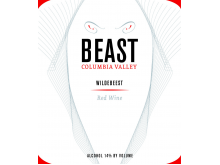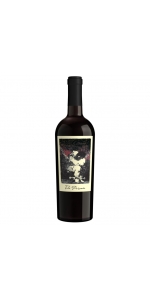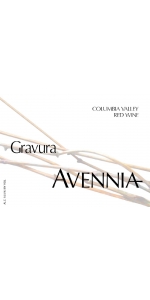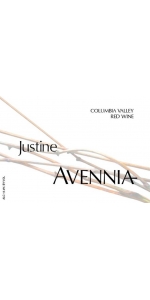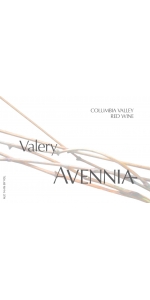Buty Wildebeest Red Blend 2011
| Country: | United States |
| Regions: | Washington Washington (Columbia Valley) |
| Winery: | Buty Winery |
| Grape Types: | Cabernet Franc Cabernet Sauvignon Syrah |
| Vintage: | 2011 |
| Bottle Size: | 750 ml |
The Prisoner Wine Company The Prisoner Red Blend is made from a blend of Zinfandel, Cabernet Sauvignon, Petite Sirah, Syrah, and Charbono.
Bright aromas of ripe raspberry, vanilla, and coconut give way to flavors of fresh and dried blackberry, pomegranate, and vanilla, which linger harmoniously for a smooth and luscious finish.The Prisoner Red Blend was inspired by the wines first made by the Italian immigrants who originally settled in Napa Valley. The Prisoner is now the most recognized red blend, leading the resurgence of interesting blends by incorporating Zinfandel with the unlikely mix of Cabernet Sauvignon, Petite Sirah, Syrah, and Charbono.
On the nose, dried blackberry, dried açai berries, and hints of cedar and tobacco leaf are accented by sweet spices of clove, cinnamon, and nutmeg. Flavors of ripe dark cherry, blackberry coulis, and hints of anise linger harmoniously for a soft, vibrant finish balanced by ripe tannins.
Chef Brett recommends pairing The Prisoner Red Blend with Kalbi Short Ribs or Chicken Mole Tostada.
Vineyards: When you outgrow winemaking tradition, you must forge your own path. And we did. The Prisoner exists because of the collaboration with our growers, many of which have been with us since the very beginning—from the Solari Family Vineyard in Calistoga, where old school sensibilities meet new techniques, to the Korte Ranch in St. Helena, a vineyard whose diligence outlasted the Prohibition and has sustained four generations.
Avennia Gravura Red Blend is made from 48% Cabernet Sauvignon, 41% Merlot, 11% Cabernet Franc
Gravura is our ode to the Graves AOC of Bordeaux, emphasizing a harmony of Cabernet Sauvignon and Merlot. The name is a play on an artisan printing technique, and on the Bordeaux region of Graves, which features similar blends. Featuring more Merlot and with the addition of Red Mountain fruit, this wine is designed to be more generous and voluptuous in style, while still remaining complex and balanced.
Gravura Tasting Notes: Beautiful nose of red and black fruits, some savory leaf notes, mocha, pencil shavings. The palate is elegant and balanced, almost pretty: raspberry, black and red currants, milk chocolate and caressing tannins. Finish medium-long and ethereal.
Avennia Justine Red Blend 56% Grenache, 31% Mourvèdre, 13% Syrah
Justine reflects our belief that Washington is capable of producing world class blends of grape varieties traditional to the Southern Rhone region of France. The name is inspired by one of the great heroines of recent literature, who also sprung from the imagination of the Mediterranean. Dark, seductive, complex, with a chasm of depth: The Justine is a great reflection of Avennia's mission of expression, and Washington's generous terroir.
Tasting Note: Big black cherry, blackberry, hints of orange peel, fresh herbs and loam on the nose. Plush and round on the palate. Dark earthy fruits from the Mourvedre, along with citrus high notes, mountain flowers, jasmine, and savory herbs. Balanced and complex without forgetting its hedonistic roots in the Southern Rhone.
Review:
A blend of 56% Grenache, 31% Mourvèdre, 13% Syrah brought up all in older oak, the 2016 Justine offers a great core of black fruits as well as lots of peppery herbs, earth, and classic meatiness. It looks to be a great vintage for this cuvée."
- Jeb Dunnuck (April 2018), 92-94 pts
Avennia Justine Red Blend 61% Grenache, 21% Mourvèdre, and 18% Syrah.
Justine reflects our belief that Washington is capable of producing world class blends of grape varieties traditional to the Southern Rhone region of France. The name is inspired by one of the great heroines of recent literature, who also sprung from the imagination of the Mediterranean. Dark, seductive, complex, with a chasm of depth: The Justine is a great reflection of Avennia's mission of expression, and Washington's generous terroir.
Tasting Note: Big black cherry, blackberry, hints of orange peel, fresh herbs and loam on the nose. Plush and round on the palate. Dark earthy fruits from the Mourvedre, along with citrus high notes, mountain flowers, jasmine, and savory herbs. Balanced and complex without forgetting its hedonistic roots in the Southern Rhone.
Review:
-Owen Bargreen 95 Points
Avennia Valery Red Blend is made from 86% Merlot and 14% Cabernet Franc
Valery is named for the patron saint of wine in the St. Emilion region that inspired it.
We started with old vine Merlot from a stony block in the heart of the Yakima Valley and added complex, aromatic Cabernet Franc from the Horse Heaven Hills. The result is a balanced, complex wine with the elegance and ethereal perfume that this blend of two of Washington’s best varietals are known for.
The nose on this wine is very perfumed, almost exotic with notes of fresh violets, red plum, winter mint, fresh herbs and crushed limestone qualities. The palate is poised and balanced, with red fruits and mocha powder encapsulated in limestone. The finish lingers delicately, with the Cabernet Franc asserting a light tobacco and herb note, giving depth. A compelling wine that will continue to unwind for 7-10 years in the cellar.
Review:
"Brought up in 30% new French oak, the 2016 Valery (70/30 Merlot and Cabernet Franc) offers more black cherry and earthy, herbal notes as well as a medium-bodied, seamless, beautifully balanced style. It too shows a vibrant, fresh, yet concentrated style that has a Bordeaux feel in its weight and texture."
- Jeb Dunnuck (April 2019), 93 pts
"Good medium-dark red. Aromas of blueberry, mocha, licorice and violet are a bit darker than those of the 2015 version. Dense and penetrating, with wild flavors of dark berries, licorice and game given lift by rocky minerality and a minty nuance. Chris Peterson slightly acidified his Cabernet Franc from Champoux Vineyard, which he added to the wine for richness. This beauty may yet tighten up in the bottle.- Stephen Tanzer"
- Antonio Galloni's Vinous (November 2018), 92+ pts
Avennia Valery Red Blend is made from 86% Merlot and 14% Cabernet Franc
Valery is named for the patron saint of wine in the St. Emilion region that inspired it.
We started with old vine Merlot from a stony block in the heart of the Yakima Valley and added complex, aromatic Cabernet Franc from the Horse Heaven Hills. The result is a balanced, complex wine with the elegance and ethereal perfume that this blend of two of Washington’s best varietals are known for.
The nose on this wine is very perfumed, almost exotic with notes of fresh violets, red plum, winter mint, fresh herbs and crushed limestone qualities. The palate is poised and balanced, with red fruits and mocha powder encapsulated in limestone. The finish lingers delicately, with the Cabernet Franc asserting a light tobacco and herb note, giving depth. A compelling wine that will continue to unwind for 7-10 years in the cellar.
Buty Wildebeest Red Blend 2011 is made from 77% Syrah, 14% Cabernet Sauvignon, 9% Cabernet Franc
BEAST is the alter ego of Buty. The mercurial nature of our BEAST wines allows us the freedom to explore new varietals, new vineyards and new blends beyond the classic Buty portfolio. Made with a clear vision and voice, these wines have developed their own faithful following. Our Wildebeest is available nationally in fine restaurants and wine shops.
Lair of the BEAST: A denizen of the Columbia Valley, the 2011 Wildebeest roams far and wide. This vintage was predominantly raised in the Horse Heaven Hills on the slopes of Phinny Hill Vineyard and nearby Champoux Vineyard. It was also reared at River Rock Vineyard and our own Rockgarden Estate in the Walla Walla Valley.
Season of the BEAST: Though the 2011 growing season started with a cool, damp spring, this presented no significant issues in the vineyards, other than to delay budbreak and flowering. A cool summer with no heat events afforded abundant hangtime, and allowed the grapes to ripen slowly and evenly, while retaining excellent acidity. In 2010, these factors combined to create BEASTs of noble stature and noteworthy complexity.
Winemaking: Our 2011 Wildebeest was blended from 77% Syrah, 14% Cabernet Sauvignon and 9% Cabernet Franc, with each lot fermented and aged separately in the finest French oak for 20 months. In order to allow the Wildebeest to display its native fruit and spice character, the barrels were generally older (from two to five years). However, approximately 25% was aged in larger-format puncheons, with one puncheon being new. Overall, the new oak is 7%. The alcohol content is 14%.
Notes Upon Encountering the Wildebeest: Our 2011 Wildebeest displays purity and power, with firm tannins, enticing aromatics and a creamy texture. Even though they are not the majority of the blend, the Bordeaux varieties shine through, with the Cabernet Sauvignon providing beautiful structure, acidity and a dark berry core, and the Cabernet Franc contributing ethereal blue fruit notes and hints of exotic spice and mint. Throughout, the Syrah adds lush layers of black cherry, raspberry and licorice, making this a rich and compelling BEAST.
The Buty Winery Estate
Pronounced "Beauty", Buty winery was founded in 2000 by owners Caleb Foster and Nina Buty, inspired by a decade of vintages from Washington and overseas. An artisan producer, Buty creates vineyard designated chardonnay, a crisp white blend and nuanced red blends—including Rediviva, Washington’s pioneering blend of syrah and cabernet sauvignon. The Rediviva of the Stones will be grown from the 2008 plantings at Rockgarden, their organic Estate vineyard in the cobblestones of Walla Walla.
Since the spring of 2001 they have worked with Californian consultant Zelma Long. Zelma’s multiple decades of worldwide winegrowing and winemaking offer a great breadth of wine and vine knowledge and a “whole business” perspective to Buty.
The philosophy of winegrowing and winemaking at Buty is one of balance, artisanship and enjoyment, as we aim to capture the essence of the grape in bottle.
The Buty Winery Vineyard
Caleb and Nina purchased 10 acres of apple orchard in Milton-Freewater in late 2006. In 2008, they organically prepared and planted Buty’s Estate, Rockgarden. The famous cobblestones section of the Walla Walla Valley appellation is located in the southeast part of the valley. In the 5% highest elevation of the cobblestones, this Grand Cru section has been the most prized farming section since the Walla Walla Valley was settled over one hundred years ago. Grand Cru is defined and set apart from its neighbors by location, history and consistently superior wines. We waited years to buy only here. Anywhere else further out in the cobblestones would have been a compromise. Developing the Estate with one wine in mind—the Rediviva of the Stones—we have densely planted clones of syrah, cabernet sauvignon, grenache, mourvèdre, marsanne and roussanne.
The Columbia Valley Appellation wines are sourced from six great estate grown vineyards. Caleb’s experience making wine from Champoux and Conner Lee Vineyards spans 16 vintages since 1992. All winegrowing stages are all maintained to Buty’s specific goals from pruning to shoot positioning, prevéraison cluster thinning, water and pest management, and the day and the time of harvest. They exclusively harvest by hand and hand berry sort on a shaker table before fermentation.
- back
Quattro Theory Chardonnay Napa Valley is made from 100 percent Chardonnay.
VISION: Working with cool-climate fruit, Landon achieves a Napa Valley Chardonnay that is more traditional in style with balanced acidity, minimal oak and non-malolactic fermentation to highlight a full range of varietal fruit expression, taking inspiration from the coastal Chardonnays of Sonoma County.
VINEYARDS: The grapes for this Chardonnay are sourced from two vineyards: three blocks in our estate Vista Montone Vineyard located just east of Carneros, and Frasamani, a long-term grower partner vineyard located in the southernmost part of Carneros. These sites were selected for the variety of vineyard aspects (N, NE) and various vine age, soils and clones, which offer a complex palette of aromas, flavors and textures. The grapes are harvested by hand at night in small lots over a few weeks, picked when perfectly poised to achieve the vision for our wine style. GROWING SEASON: 2022 brought dry conditions given the persisting drought. Harvest started earlier given the warm temperatures with the fruit showcasing balanced acidity and freshness with remarkable flavors and textures. Even though yields were down, quality was excellent.
WINEMAKING: Our cellar is set up to handle each lot individually through the winemaking process, with every step intentionally designed to emphasize the natural aromatic and varietal character with minimal intervention. Each pick is whole-cluster pressed over two hours, with 23 check ins to ensure desired style— a gentle, yet labor-intensive program to help retain natural acidity and to isolate the exact desired press of juice. The juice is gently pumped to stainless-steel tanks then chilled to undergo cold stabulation for 5 days, keeping the light juice lees in suspension to enhance aromatics. The juice is then racked off the lees to each vessel and individually inoculated to begin a cold fermentation to completely dry, and then rests on the lees (yeast) for 6 months for a final build of body and flavors before the blend is assembled.
EXPERIENCE: With its expressive flavors and restrained oak presence, this Chardonnay offers the balance, structure and complexity to make it a perfect white wine option to go with food or enjoyed on its own. This wine’s range of fruit flavors includes crisp Asian pear, to stone fruit to tropical fruit. Suggested pairings include pan-seared scallops, butternut squash ravioli and mushroom and mozzarella pizza.
Review:
Bright, fresh green apples in the nose and tangy, appetizing lemon zest and kiwis on the palate give this lively wine a palate-cleansing expression that will be fantastic for pairing with fish, shellfish and poultry.
-Wine Enthusiast 93 Points
Torello Corpinnat Finca Can Marti Brut 32% Chardonnay, 32% Xarel.lo, 22% Macabeo and 14% Parellada.
The Can Martí estate soils have been formed from sediments from the Garraf Massis, deposited thousands of years ago. One of the most characteristic features of the estate’s soils is the presence of accumulations of calcium carbonate.The movement of water through the soil dissolves the carbonates present and takes them to a certain depth. The continuous repetition of this process has ended up producing the accumulation of these deposits.When these become massive, after thousands of years, they bind together and and form a hard stratum called a petrocalcic horizon. This hard stratum limits the availbility of water to the vine and the production, but is a factor that gives the grape quality.
Straw yellow color, fine and constant bubbles, clean and bright, with golden reflections. The nose reveals a subtle aromatic intensity with fresh and sweet aromas. Honey flowers, citrus notes, white fruit, and balsamic herbs such as fennel.
In the mouth the acidity is well balanced, with delicate bitter notes to the finish and a set of ripe fruits and balsamic nuances.

